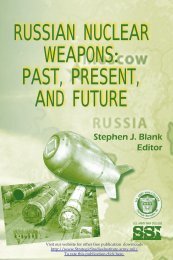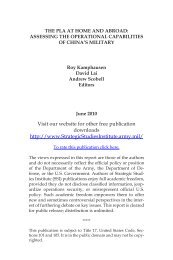Warriors in Peace Operations - Strategic Studies Institute - U.S. Army
Warriors in Peace Operations - Strategic Studies Institute - U.S. Army
Warriors in Peace Operations - Strategic Studies Institute - U.S. Army
You also want an ePaper? Increase the reach of your titles
YUMPU automatically turns print PDFs into web optimized ePapers that Google loves.
detachments developed standard operat<strong>in</strong>g procedures<br />
(SOPs) and checklists for each stage of the process. These<br />
proved to be most beneficial, because it told each soldier<br />
exactly what tasks had to be done and how to do them (the<br />
standard), and what hours they could be accomplished <strong>in</strong>.<br />
This was essential because supply rooms and arms rooms<br />
could not be open all day long, and the leaders could not be<br />
everywhere to answer questions.<br />
In order to transition soldiers <strong>in</strong> and out of the unit, the<br />
detachments had to run a supply room and an arms room.<br />
To lessen the manpower requirements, rema<strong>in</strong><strong>in</strong>g supplies<br />
and weapons were consolidated <strong>in</strong>to one detachment arms<br />
room and supply room <strong>in</strong> the battalion. Properly operat<strong>in</strong>g<br />
these was more challeng<strong>in</strong>g, s<strong>in</strong>ce supply clerks and<br />
armorers require skills and knowledge that signal soldiers<br />
do not readily possess. There was no good solution for this<br />
problem except for OJT. I had the S-2 from one of the other<br />
battalions conduct security <strong>in</strong>spections and <strong>in</strong>struction <strong>in</strong><br />
ma<strong>in</strong>ta<strong>in</strong><strong>in</strong>g the paperwork and control of the keys. If a<br />
weapon needed ma<strong>in</strong>tenance, it was taken directly to the<br />
Direct Support Ma<strong>in</strong>tenance facility. We were not capable of<br />
perform<strong>in</strong>g organizational ma<strong>in</strong>tenance. On the supply<br />
side, hand receipts were used to keep accountability, but,<br />
with soldiers com<strong>in</strong>g and go<strong>in</strong>g daily, it was a difficult task.<br />
When supplies needed to be ordered, the detachments had<br />
to go to my property book officer (PBO) for assistance, as the<br />
rear detachments did not have a document register or<br />
money of their own.<br />
The one resource always <strong>in</strong> short supply, but always <strong>in</strong><br />
great demand, was transportation. Seven days a week the<br />
rear detachment commanders had to haul soldiers to and<br />
from tra<strong>in</strong><strong>in</strong>g and airfields. The brigade had left a couple of<br />
tactical vehicles beh<strong>in</strong>d, but almost all of those had shelters<br />
mounted on them. The Transportation Motor Pool (TMP)<br />
tried valiantly to meet all the requirements, but clearly had<br />
not foreseen the <strong>in</strong>crease <strong>in</strong> demand. To be truthful, no one<br />
accurately predicted the rear detachments’ requirements<br />
for support vehicles. Soldiers had to be taken to ranges and<br />
241
















